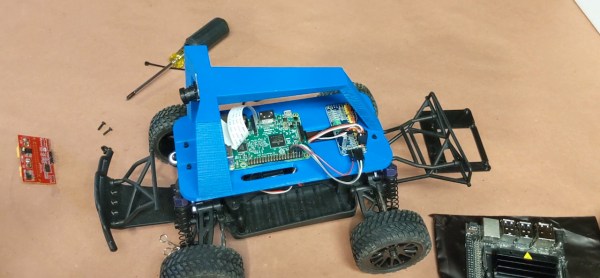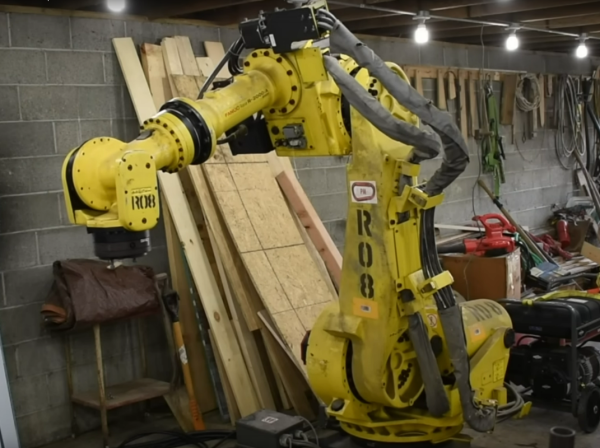For a brief window of time in the mid-2010s, a fairly common joke was to send voice commands to Alexa or other assistant devices over video. Late-night hosts and others would purposefully attempt to activate voice assistants like these en masse and get them to do ridiculous things. This isn’t quite as common of a gag anymore and was relatively harmless unless the voice assistant was set up to do something like automatically place Amazon orders, but now that much more powerful AI tools are coming online we’re seeing that joke taken to its logical conclusion: prompt-injection attacks. Continue reading “Prompt Injection: An AI-Targeted Attack”
Author: Bryan Cockfield1709 Articles
Custom Glove Guides Wearers’ Dreams
For as much advancement as humanity has made in modern medicine even in the last century alone, there’s still plenty we don’t understand about the human body. That’s particularly true of the brain, where something as common as dreams are the subject of active debate about their fundamental nature, if they serve any purpose, and where they originate. One research team is hoping to probe a little further into this mystery, and has designed a special glove to help reach a little deeper into the subconscious brain.
The glove, called Dormio, has a number of sensors and feedback mechanisms which researchers hope will help explore the connection between dreaming and creativity. Volunteers were allowed to take a nap while wearing the glove, which can detect the moment they began entering a specific stage of sleep. At that point, the device would provide an audio cue to seed an idea into the dreams, in this case specifically prompting the sleeper to think about trees. Upon awakening, all reported dreaming about trees specifically, and also demonstrated increased creativity in tests compared to control groups.
While this might not have the most obvious of implications, opening the brain up to being receptive of more creative ideas can have practical effects beyond the production of art or music. For example, the researchers are also investigating whether the glove can help individuals with post-traumatic stress disorder manage nightmares. From a technical perspective this glove isn’t much different from some other devices we’ve seen before, and replicating one to perform similar functions might be possible for most of us willing to experiment on ourselves.
An Entire RISC-V Operating System In 2000 Lines
While Microsoft and Apple don’t release the source code for their operating systems, a good estimate is that it takes around 50 million lines of code to run these software behemoths. The Linux kernel alone holds around 30 million lines, with systemd containing over one million lines on its own, which doesn’t include estimates for the desktop environment or other parts of a standard installation. But millions of lines of code, or even hundreds of thousands, aren’t necessary for building a fully functioning operating system. This one sets up a complete OS in exactly 2000 lines of code.
Called egos-2000, short for Earth and Grass Operating System, the diminutive operating system is written for RISC-V computers and while it does contain most of the tools we would recognize in an OS, it was built specifically for computer science students by PhD candidate Yunhao Zhang. The slimmed-down operating system makes it possible for students to easily read and understand every feature of an operating system without it becoming too overwhelming, and can be easily used and modified to experiment with. The name itself comes from its design principles, where parts of the operating system that interact with hardware directly are part of the “Earth” layer and parts that don’t depend on hardware being placed in the “Grass” layer, with applications taking up a third layer.
The OS is available on this GitHub page under an MIT license and works on real RISC-V hardware as well as within various emulators. Building a complete operating system in so few lines of code is an impressive feat, and making it comprehensive enough to teach students with goes well beyond that accomplishment as well. Often when concepts in computer science are reduced to their bare minimum components, we end up with completely illegible (but interesting) experiments like this programming language instead.
Badminton Inspired Heat Shield Aims To Fly This Year
Badminton is not a sport that most of us think about often, and extremely rarely outside of every four years at the summer Olympics and maybe at the odd cookout or beach party here or there. But the fact that it’s a little bit unique made it the prime inspiration for this new heat shield design, which might see a space flight and test as early as a year from now.
The inspiration comes from the shuttlecock, the object which would otherwise be a ball in any other sport. A weighted head, usually rubber or cork, with a set of feathers or feather-like protrusions mounted to it, contributes to its unique flight characteristics when hit with a racquet. The heat shield, called Pridwen and built by Welsh company Space Forge, can be folded before launch and then expanded into this shuttlecock-like shape once ready for re-entry. It’s unlikely this will protect astronauts anytime soon, though. The device is mostly intended for returning materials from the Moon or from asteroids, or for landing spacecrafts on celestial bodies with atmospheres like Mars or Venus.
With some testing done already, Space Forge hopes this heat shield will see a space flight before the close of 2023. That’s not the end of the Badminton inspiration either, though. It’s reported that this device can slow a re-entering craft so much that it can be caught in a net. Not exactly the goal when playing the sport, but certainly a welcome return home for whichever craft might use this system. Of course, getting down from space is only half the battle. Take a look at this other unique spacecraft that goes up in a fairly non-traditional way instead.
Self-Driving Library For Python
Fully autonomous vehicles seem to perennially be just a few years away, sort of like the automotive equivalent of fusion power. But just because robotic vehicles haven’t made much progress on our roadways doesn’t mean we can’t play with the technology at the hobbyist level. You can embark on your own experimentation right now with this open source self-driving Python library.
Granted, this is a library built for much smaller vehicles, but it’s still quite full-featured. Known as Donkey Car, it’s mostly intended for what would otherwise be remote-controlled cars or robotics platforms. The library is built to be as minimalist as possible with modularity as a design principle, and includes the ability to self-drive with computer vision using machine-learning algorithms. It is capable of logging sensor data and interfacing with various controllers as well, either physical devices or through something like a browser.
To build a complete platform costs around $250 in parts, but most things needed for a Donkey Car compatible build are easily sourced and it won’t be too long before your own RC vehicle has more “full self-driving” capabilities than a Tesla, and potentially less risk of having a major security vulnerability as well.
Industrial Robot Gets Open-Source Upgrade
Industrial robots are shockingly expensive when new, typically only affordable for those running factories of some sort. Once they’ve gone through their life cycle building widgets, they can be purchased for little more than scrap value, which is essentially free compared to their original sticker price. [Excessive Overkill] explains all of this in a video where he purchased one at this stage to try to revive, but it also shows us how to get some more life out of these robots if you can spend some time hunting for spare parts, installing open-source firmware, and also have the space for a robot that weighs well over a thousand kilograms.
This specific robot is a Fanuc R2000ia with six degrees of freedom and a reach of over two meters. Originally the plan was to patch together a system that could send modern gcode to the Fanuc controller, but this was eventually scrapped when [Excessive Overkill] realized the controller that shipped with this robot was for an entirely different machine and would never work. Attempts to find upgraded firmware were frustrated, and after a few other false starts a solution was found to get the robot working again using LinuxCNC and Mesa FPGA cards, which have built-in support for Fanuc devices like this.
More after the break…
Continue reading “Industrial Robot Gets Open-Source Upgrade”
Tiny Bitcoin Miner Plays The Lottery
Usually when we think of Bitcoin miners, we imagine huge facilities of server racks doing nothing but essentially wasting energy, all for the chance that one of those computers amongst the rows will stumble upon the correct set of numbers to get rewarded with imaginary money. The idea being that the more computers, the more chances to win. But just buying one lottery ticket is the only thing technically required to win, at least in theory. And [Data Slayer] is putting this theory to the test with this Bitcoin miner built around a single Raspberry Pi.
This tiny Raspberry Pi Zero does get a little bit of support from an Ant Miner, a USB peripheral which is optimized to run the SHA256 hashing algorithm and solve the complex mathematical operations needed to “win” the round of Bitcoin mining. Typically a large number of these would be arrayed together to provide more chances at winning (or “earning”, to use the term generously) Bitcoin but there’s no reason other than extreme statistical improbability that a single one can’t work on its own. The only other thing needed to get this setup working is to give the Pi all of the configuration information it needs such as wallet information and pool information.
This type of miner isn’t novel by any means, and in fact it’s a style of mining cryptocurrency called “lottery mining” where contributing to a pool is omitted in favor of attempting to solve the entire block by pure random chance alone in the hopes that if it’s solved, the entire reward will be claimed by that device alone. In the case of this device, the current hash rate calculated when it was contributing to a pool means that when lottery mining, it has about a one-in-two-billion chance of winning. That’s essentially zero, which is basically the same chance of winning a lottery that pays out actual usable currency.

















